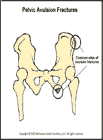
Pelvic Avulsion Fractures
What is a pelvic avulsion fracture?
There are several muscles in the thigh that attach to various parts of the pelvis. An avulsion is the tearing away of a body part from its point of attachment. An avulsion fracture occurs when a tendon that attaches a muscle to a bone pulls part of the bone away.
How does it occur?
An avulsion fracture may occur after sudden, forceful contraction of the muscle. It is often seen in athletes with tight muscles. Common sites for avulsion fractures include where the sartorius muscle attaches to the top front of the pelvis; where the rectus femoris muscle attaches to the front of the pelvis; where the hamstring muscle group attaches to the part of the pelvis called the ischial tuberosity (the part of your pelvis that you sit on).
What are the symptoms?
You pain at the attachment site of the muscles. There is tenderness and swelling.
How is it diagnosed?
Your health care provider will review your symptoms and examine the injured area. Since the muscle has been torn away from its attachment site, it is possible that you may not be able to perform a muscle function. Your health care provider may order an x-ray that would show a piece of bone pulled away from its muscular attachment site.
How is it treated?
These avulsion fractures require rest. In general, they will heal with 4 to 6 weeks of rest. You may need to use crutches for most of this time. If the bony fragment is large or is torn away from its original site by a significant distance, surgery may be required.
At the time of the initial injury you should apply ice to the area for 20 to 30 minutes every 3 to 4 hours for 2 to 3 days or until the pain goes away. Your health care provider may prescribe anti-inflammatory medications.
When can I return to my sport or activity?
The goal of rehabilitation is to return you to your sport or activity as soon as is safely possible. If you return too soon you may worsen your injury, which could lead to permanent damage. Everyone recovers from injury at a different rate. Return to your sport or activity will be determined by how soon the injured area recovers, not by how many days or weeks it has been since your injury occurred. In general, the longer you have symptoms before you start treatment, the longer it will take to get better.
You may safely return to your sport or activity when, starting from the top of the list and progressing to the end, each of the following is true:
- You have full range of motion in the injured leg compared to the uninjured leg.
- You have full strength of the injured leg compared to the uninjured leg.
- You can jog straight ahead without pain or limping.
- You can sprint straight ahead without pain or limping.
- You can do 45-degree cuts, first at half-speed, then at full-speed.
- You can do 20-yard figures-of-eight, first at half-speed, then at full-speed.
- You can do 90-degree cuts, first at half-speed, then at full-speed.
- You can do 10-yard figures-of-eight, first at half-speed, then at full-speed.
- You can jump on both legs without pain and you can jump on the injured leg without pain.
How can pelvic avulsion fractures be prevented?
Since tight muscles are a common cause of avulsion fractures, be sure to do stretching exercises to prevent these injuries from happening again. Warm up properly and stretch your thigh, hamstring, and groin muscles before your activity.

